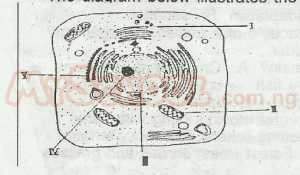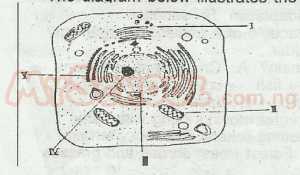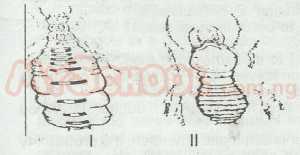In which of the following organisms is the siphon found?
- A. Tadpole
- B. Pupa of mosquito
- C. Tilapia
- D. Crayfish
- E. Butterfly

The structure labelled V is the
- A. mitochondrion
- B. ribosome
- C. nucleus
- D. centriole
- E. nucleolus

The structure that produces the energy required by the cell is labelled
- A. I
- B. II
- C. III
- D. IV
- E. V
The gradual, cumulative, adaptive and heritable changes in an organism over a long period of time resulting
in emergence of new species is known as
- A. adaption
- B. survival
- C. regeneration
- D. variation
- E. organic evolution
Which of the following does not imply attempt at conservation?
- A. Limit on the size of nets used in fishing
- B. Limit on the size of vessels to be used in fishing
- C. Prohibition of hunting or fishing at a certain season
- D. Prudent management of natural resources
- E. Retraining from the use of the natural resource
Which of the following is the least safe method of birth control? Using
- A. spermicide creams
- B. contraceptive pills
- C. barriers such as condoms
- D. intrauterine device
- E. the withdrawal method
The deficiency of calcium in a plant may result in
- A. stunted growth and poor root development
- B. poor growth, leaves become orange or brown
- C. stunted growth, slender stem and yellowing of leaves
- D. very small leaves and yellowing of leaves
- E. tall weedy and reddish leaves, `
The process whereby poisonous compounds are made harmless in the liver is called
- A. deamination
- B. glycolysis
- C. dehydration
- D. detoxification
- E. denitritication
Mutation leads to evolution in that it
- A. gives rise to offspring which have the same characteristics as the parents
- B. kill all organism where it has occurred
- C. gives rise to new individuals which differs considerably from their parents
- D. always confers adaptability of the offspring
- E. does nit confer adaptability to the offspring
The part of the ear which equalizes air pressure on either side of the eardrum is
the
- A. auditory meatus
- B. malleus
- C. Eustachian tube
- D. oval window
- E. stapes
The following conditions form the basis of competition in a habitat except
- A. food
- B. space
- C. reproductive mate
- D. light
- E. body structure
Which of the following factors does not control population growth?
- A. Food shortage
- B. Emigration
- C. Abundance of food
- D. Predation
- E. Natural disaster
Which of these is not part of the appendicular skeleton?
- A. Clavicle
- B. Vertebral column
- C. Scapula
- D. Femur
- E. Humerus

What is the theoretical probability that a normal male child will be born?
- A. 1\2
- B. 1\4
- C. 1\3
- D. 1
- E. 2\3

Which of the following determines a normal male offspring?
- A. X
- B. Y
- C. XX
- D. XY
- E. YY

In their system of organisation, the diagram labelled II plays the role of a
- A. worker
- B. soldier
- C. queen
- D. drone
- E. reproductive

The diagrams above represent a group of insects known to be
- A. colonial
- B. parasitic
- C. soldier
- D. carnivorous
- E. symbiotic
What is the fate of the ovary of a flower after fertilization?
- A. becomes the seed
- B. withers away
- C. becomes the fruit
- D. develops more nuclei
- E. develops into sepals.
The ability of the eye to alter the focal length of the lens, with regard to the distance of the object from
the eye is known as
- A. binocular vision
- B. nocturnal vision
- C. distortion
- D. accommodation
- E. focusing
Muscles are attached to bones by means of
- A. ligament
- B. cartilage
- C. capillaries
- D. tendons
- E. arteries
The structure used by fishes to detect the presence and movement of other animals
by the vibration they produce is the
- A. eye
- B. nostril
- C. lateral line
- D. scales
- E. fins


